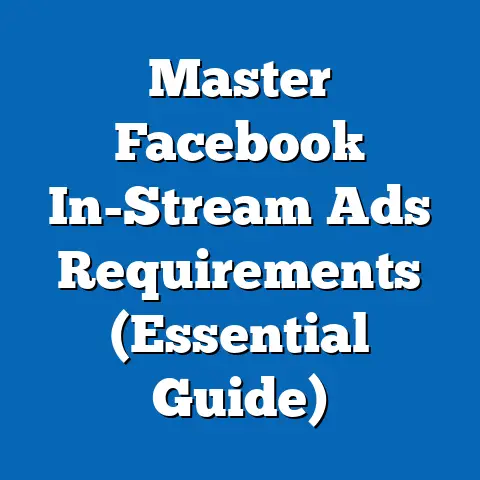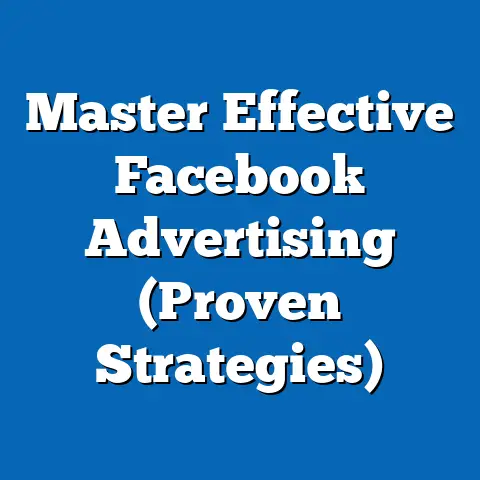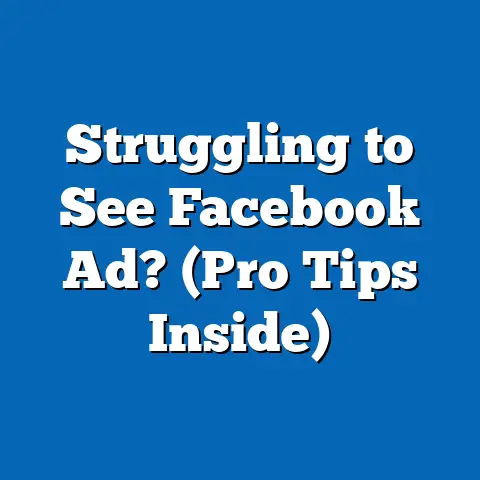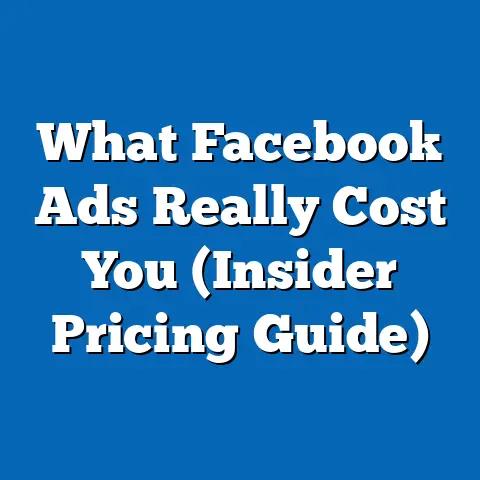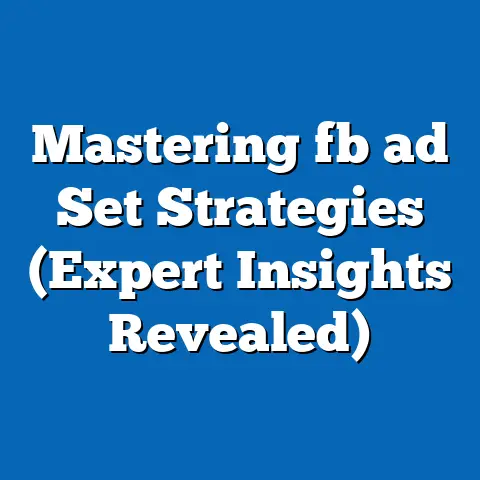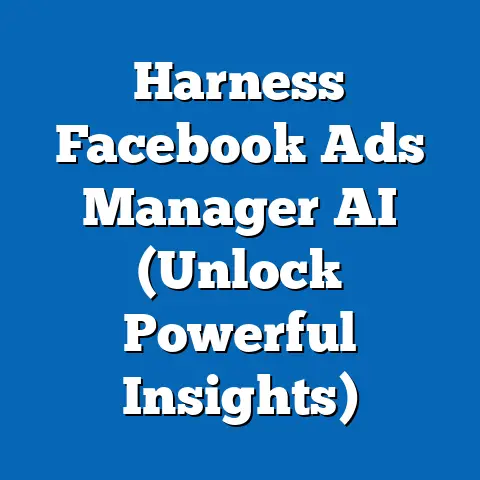Revamp Automotive Facebook Ads (Expert Strategies Inside)
Are your automotive Facebook ads failing to ignite leads and sales? Do you feel like your current ad strategy is stuck in neutral, spinning its wheels without getting you anywhere? You’re not alone. I’ve seen countless automotive businesses struggle to navigate the ever-changing landscape of Facebook advertising. It can feel like you’re throwing money into a black hole, hoping something sticks.
But what if I told you there’s a way to supercharge your automotive Facebook ads, turning them into a powerful engine for growth? I’m not talking about quick fixes or gimmicks. I’m talking about a strategic overhaul, a deep dive into the nuances of the automotive market on Facebook, and a proven roadmap to success.
Think about it: millions of potential customers are scrolling through Facebook every single day, many of them actively researching their next vehicle purchase or looking for reliable service providers. The opportunity is immense, but only if you know how to reach them effectively.
Over the years, I’ve helped dealerships, aftermarket suppliers, and car service providers transform their Facebook advertising, and I’ve seen firsthand the incredible results that are possible. One of my clients, a local dealership, saw a 30% increase in qualified leads within just two months of implementing the strategies I’m about to share. Another, an online retailer of aftermarket parts, doubled their sales through a targeted retargeting campaign.
In this guide, I’ll share with you the expert strategies I’ve learned, refined, and proven over the years. We’ll cover everything from understanding the automotive market on Facebook to crafting compelling ad content, mastering targeting and retargeting, optimizing your budget, and analyzing your campaign performance.
Consider this your pit stop for revitalizing your automotive Facebook ads. Let’s shift your strategy into high gear and drive real results.
Section 1: Understanding the Automotive Market on Facebook
Before you even think about creating an ad, you need to understand the unique dynamics of the automotive market on Facebook. It’s not the same as selling shoes or promoting a restaurant. The automotive purchase journey is typically longer, more complex, and involves a higher degree of consideration.
The Unique Characteristics of the Automotive Market on Facebook
- High Involvement Purchase: Buying a car is a significant financial decision. People don’t impulse buy vehicles (usually!). They research, compare, and consider their options carefully. This means your Facebook ads need to provide valuable information and build trust.
- Longer Sales Cycle: From initial awareness to final purchase, the automotive sales cycle can span weeks or even months. Your advertising strategy needs to nurture leads over time, providing consistent value and staying top-of-mind.
- Multiple Touchpoints: Customers often interact with your brand across multiple channels before making a decision. Your Facebook ads should integrate seamlessly with your website, email marketing, and other touchpoints.
- Local Focus: For dealerships and service providers, location is critical. Your targeting needs to be precise to reach potential customers in your service area.
- Visual Appeal: Let’s face it, cars are visually appealing. Your ads need to showcase your vehicles in their best light, using high-quality images and videos.
Targeting the Right Automotive Audience on Facebook
The beauty of Facebook advertising lies in its precise targeting capabilities. You’re not just broadcasting your message to the masses; you’re reaching specific segments of the population who are most likely to be interested in your products or services. Here are some common automotive audience segments:
- First-Time Buyers: These are often younger individuals or families looking for affordable and reliable transportation. Focus on value, safety, and practicality in your ads.
- Enthusiasts: These are passionate car lovers who are interested in performance, customization, and the latest automotive technology. Target them with ads showcasing high-performance vehicles, aftermarket parts, and automotive events.
- Luxury Consumers: These are affluent individuals who prioritize comfort, style, and prestige. Showcase your luxury vehicles with ads highlighting their features, craftsmanship, and exclusive benefits.
- Families: These are buyers looking for spacious and safe vehicles with features that cater to their needs. Target them with ads featuring SUVs, minivans, and family-friendly sedans.
- Truck Owners: This audience is interested in trucks for work or recreation. Highlight the towing capacity, durability, and off-road capabilities of your trucks.
- Electric Vehicle (EV) Enthusiasts: This growing segment is interested in environmentally friendly and technologically advanced vehicles. Target them with ads showcasing the benefits of EVs, such as fuel efficiency, performance, and tax incentives.
- Aftermarket Shoppers: This group is looking for parts and accessories to upgrade their existing vehicles. Target them with specific ads for products like tires, wheels, performance parts, and audio systems.
- Service Seekers: This audience is looking for reliable and affordable car maintenance and repair services. Target them with ads promoting oil changes, tire rotations, brake repairs, and other services.
I once worked with a dealership that was struggling to reach first-time buyers. Their ads were too focused on luxury features and high-end models. By creating a separate campaign specifically targeting this segment with ads highlighting affordable and fuel-efficient vehicles, they saw a significant increase in leads from younger buyers.
The Power of Customer Personas
To truly connect with your target audience, you need to develop detailed customer personas. These are fictional representations of your ideal customers, based on research and data about your existing customers.
A customer persona should include:
- Demographics: Age, gender, location, income, education, occupation.
- Psychographics: Interests, values, lifestyle, personality.
- Goals: What are they trying to achieve with their vehicle purchase or service?
- Pain Points: What are their biggest frustrations and challenges?
- Buying Behavior: How do they research and make decisions? What are their preferred channels of communication?
For example, a persona for a first-time buyer might look like this:
- Name: Sarah
- Age: 25
- Location: Urban area
- Occupation: Marketing assistant
- Income: $40,000
- Goals: Find a reliable and affordable car for commuting to work and weekend trips.
- Pain Points: Worried about car payments, maintenance costs, and finding a trustworthy mechanic.
- Buying Behavior: Researches online reviews, compares prices, and seeks recommendations from friends and family.
By understanding Sarah’s needs and motivations, you can create Facebook ads that resonate with her and address her specific concerns.
Automotive Facebook Ad Success Stories
Numerous automotive brands have achieved remarkable results with Facebook advertising. Here are a few examples:
- BMW: Used Facebook to generate leads for its electric vehicle lineup, resulting in a significant increase in test drive bookings.
- Ford: Leveraged Facebook to promote its new truck models, targeting specific demographics and interests, leading to a surge in sales.
- Goodyear: Used Facebook to drive traffic to its website and increase online tire sales, targeting customers based on their vehicle type and driving habits.
- Local Dealerships: Many local dealerships have successfully used Facebook to generate leads for new and used vehicles, as well as service appointments.
Key Takeaway: Understanding the automotive market on Facebook, defining your target audience, and developing customer personas are crucial steps in creating effective advertising campaigns. Don’t skip these foundational elements!
Next Step: Identify your key target audiences and create detailed customer personas for each segment.
Section 2: Crafting Compelling Ad Content
Now that you understand your audience, it’s time to create ad content that grabs their attention and compels them to take action. In the noisy world of social media, your ads need to stand out and deliver a clear, relevant message.
The Essential Components of an Effective Automotive Facebook Ad
- Persuasive Copy: Your ad copy should be concise, engaging, and focused on the benefits of your product or service. Highlight the key features that resonate with your target audience.
- High-Quality Visuals: Use stunning images or videos that showcase your vehicles in their best light. Make sure your visuals are relevant to your ad copy and target audience.
- Clear Call-to-Action (CTA): Tell your audience exactly what you want them to do. Use strong action verbs like “Shop Now,” “Get a Quote,” “Book a Test Drive,” or “Learn More.”
- Relevance: Your ad should be relevant to the interests and needs of your target audience. Use Facebook’s targeting options to ensure your ads are seen by the right people.
Storytelling: Connecting with Your Audience on an Emotional Level
People connect with stories. Instead of just listing features and specifications, try to create a narrative around your vehicles, services, or customer experiences.
- Highlight Customer Success Stories: Share stories of satisfied customers who have benefited from your products or services.
- Focus on the Emotional Benefits: How will your vehicle or service make your customers feel? Will it give them a sense of freedom, adventure, or security?
- Create a Sense of Community: Position your brand as a part of your customers’ lives, not just a provider of products or services.
For example, instead of just saying “Our SUVs have great safety features,” you could tell a story about a family who was protected in an accident thanks to the advanced safety technology in your vehicle.
Leveraging Video Content
Video is one of the most engaging formats on Facebook. Use video to showcase your vehicles, highlight key features, and share customer testimonials.
- Create Short, Attention-Grabbing Videos: Keep your videos concise and focused on the most important information. Aim for videos that are 15-30 seconds long.
- Use Eye-Catching Visuals: Make sure your videos are visually appealing and well-produced.
- Add Captions: Many people watch videos on Facebook with the sound off. Use captions to make sure your message is still clear.
- Experiment with Different Video Formats: Try live videos, behind-the-scenes footage, and customer interviews.
The Power of Carousel Ads
Carousel ads allow you to showcase multiple images or videos in a single ad unit. This is a great way to highlight different features of your vehicles or promote a range of services.
- Showcase Different Angles of Your Vehicle: Use carousel ads to display your vehicle from multiple angles, highlighting its design and features.
- Promote Different Services: Use carousel ads to showcase your different service offerings, such as oil changes, tire rotations, and brake repairs.
- Tell a Story: Use carousel ads to tell a story about your brand or customer experiences.
Interactive Ad Formats
Facebook offers a variety of interactive ad formats that can help you engage your audience and generate leads.
- Lead Ads: Use lead ads to collect contact information from potential customers without them having to leave Facebook.
- Instant Experiences: Use instant experiences to create immersive, full-screen experiences that showcase your vehicles or services.
- Poll Ads: Use poll ads to gather feedback from your audience and learn more about their preferences.
I once helped a car service provider create a poll ad asking customers what their biggest car maintenance concern was. The results helped them tailor their service offerings and create more targeted advertising campaigns.
Examples of High-Performing Automotive Ads
Let’s take a look at some examples of high-performing automotive ads and analyze what makes them successful:
- BMW: A video ad showcasing the performance and luxury of their M series vehicles. The ad featured stunning visuals, a powerful soundtrack, and a clear call-to-action to “Learn More.”
- Ford: A carousel ad highlighting the different features of their F-150 truck. The ad targeted truck owners and outdoor enthusiasts and featured a clear call-to-action to “Build Your Own.”
- Goodyear: A lead ad promoting their latest tire sale. The ad targeted customers based on their vehicle type and driving habits and offered a free tire pressure check.
- Local Dealership: An instant experience ad showcasing their new inventory of SUVs. The ad featured high-quality images, detailed specifications, and a clear call-to-action to “Schedule a Test Drive.”
What makes these ads successful?
- They are visually appealing and engaging.
- They are relevant to the target audience.
- They have a clear call-to-action.
- They tell a compelling story.
Key Takeaway: Compelling ad content is the key to capturing your audience’s attention and driving results. Focus on creating visually appealing ads that tell a story and offer a clear call-to-action.
Next Step: Review your existing ad content and identify areas for improvement. Experiment with different ad formats and messaging to see what resonates best with your target audience.
Section 3: Targeting and Retargeting Strategies
You can have the most beautiful ad in the world, but if it’s not seen by the right people, it’s worthless. That’s where Facebook’s advanced targeting options come into play.
Leveraging Facebook’s Advanced Targeting Options
Facebook allows you to target your ads based on a wide range of criteria, including:
- Demographics: Age, gender, location, education, occupation, relationship status.
- Interests: Hobbies, activities, pages they like, groups they belong to.
- Behaviors: Purchase history, online activity, device usage, travel habits.
- Custom Audiences: People who have interacted with your website, app, or CRM data.
- Lookalike Audiences: People who are similar to your existing customers.
For the automotive niche, here are some specific targeting options to consider:
- Interests: “Automotive,” “Cars,” “Trucks,” “SUVs,” “Motorcycles,” “Car Enthusiasts,” “Auto Racing,” “Classic Cars,” “Electric Vehicles.”
- Behaviors: “Purchased a vehicle in the last 6 months,” “Interested in car loans,” “Visited a car dealership website,” “Used a car comparison website.”
- Demographics: “Age 25-54,” “Income above $50,000,” “Homeowners.”
The Power of Retargeting: Re-Engaging Potential Customers
Retargeting allows you to re-engage potential customers who have already shown interest in your products or services. This is a highly effective strategy because you’re targeting people who are already familiar with your brand and are further down the sales funnel.
- Website Visitors: Retarget people who have visited your website but haven’t made a purchase or filled out a lead form.
- Video Viewers: Retarget people who have watched your videos on Facebook.
- Lead Form Engagers: Retarget people who have interacted with your lead forms but haven’t submitted their information.
- CRM Contacts: Upload your customer list to Facebook and retarget your existing customers with special offers or promotions.
I once worked with an aftermarket parts retailer who saw a 50% increase in sales by implementing a retargeting campaign targeting website visitors who had abandoned their shopping carts.
Setting Up Custom Audiences
Custom audiences allow you to target your ads to specific groups of people based on your own data. Here’s how to set them up:
- Go to Facebook Ads Manager.
- Click on “Audiences.”
- Click on “Create Audience” and select “Custom Audience.”
- Choose your data source:
- Website: Track website visitors using the Facebook Pixel.
- Customer List: Upload your CRM data.
- App Activity: Track users of your mobile app.
- Offline Activity: Track in-store purchases or other offline interactions.
- Video: Target people who have watched your videos on Facebook.
- Lead Form: Target people who have interacted with your lead forms.
- Instant Experience: Target people who have interacted with your Instant Experiences.
- Events: Target people who have attended your events.
- Facebook Page: Target people who have interacted with your Facebook page.
- Follow the instructions to create your custom audience.
- Website: Track website visitors using the Facebook Pixel.
- Customer List: Upload your CRM data.
- App Activity: Track users of your mobile app.
- Offline Activity: Track in-store purchases or other offline interactions.
- Video: Target people who have watched your videos on Facebook.
- Lead Form: Target people who have interacted with your lead forms.
- Instant Experience: Target people who have interacted with your Instant Experiences.
- Events: Target people who have attended your events.
- Facebook Page: Target people who have interacted with your Facebook page.
Creating Lookalike Audiences
Lookalike audiences allow you to target your ads to people who are similar to your existing customers. This is a great way to expand your reach and find new potential customers. Here’s how to create a lookalike audience:
- Go to Facebook Ads Manager.
- Click on “Audiences.”
- Click on “Create Audience” and select “Lookalike Audience.”
- Choose your source audience: This can be a custom audience, a Facebook page, or your website.
- Select your lookalike audience size: This determines how closely the lookalike audience will match your source audience. A smaller audience will be more similar, while a larger audience will have broader reach.
- Select the countries you want to target.
- Click on “Create Audience.”
Real-World Examples of Targeting and Retargeting Success
- Dealership: A dealership used a custom audience of website visitors who had viewed specific vehicle models to retarget them with ads featuring special offers and financing options. This resulted in a significant increase in test drive bookings.
- Aftermarket Supplier: An aftermarket supplier used a lookalike audience based on their existing customer list to target new customers who were likely to be interested in their products. This resulted in a lower cost per acquisition and a higher conversion rate.
- Car Service Provider: A car service provider used a custom audience of people who had watched their videos on Facebook to retarget them with ads promoting their services. This resulted in a significant increase in service appointments.
Key Takeaway: Mastering Facebook’s targeting and retargeting options is essential for reaching the right audience and maximizing your ROI. Don’t rely on broad targeting; get specific and laser-focused on your ideal customers.
Next Step: Set up custom audiences and lookalike audiences based on your website data, CRM data, and video engagement. Experiment with different targeting options to see what works best for your business.
Section 4: Budgeting and Bidding Strategies
Setting the right budget and choosing the right bidding strategy are crucial for maximizing your ROI on Facebook. You don’t want to overspend and waste money, but you also don’t want to underspend and miss out on potential customers.
Setting a Realistic Budget for Automotive Facebook Ads
The right budget for your Facebook ad campaigns will depend on several factors, including:
- Your Business Goals: What are you trying to achieve with your advertising? Are you trying to generate leads, drive sales, or increase brand awareness?
- Your Target Market Size: How many people are you trying to reach with your ads?
- Your Competition: How much are your competitors spending on Facebook advertising?
- Your Conversion Rate: How many people who see your ads actually take the desired action (e.g., fill out a lead form, make a purchase)?
- Your Cost Per Acquisition (CPA): How much are you willing to spend to acquire a new customer?
As a general guideline, I recommend starting with a daily budget of at least \$20-\$50 per ad set. You can then adjust your budget based on your performance data.
It’s important to remember that Facebook advertising is an investment, not an expense. You need to be willing to spend money to see results. However, you also need to be smart about how you spend your money.
Understanding Facebook Bidding Strategies
Facebook offers a variety of bidding strategies that you can use to optimize your ad campaigns. Here are some of the most common options:
- Highest Volume: This bidding strategy aims to get you the most results for your budget. Facebook will automatically bid on ad auctions to maximize your reach and impressions. This is a good option if you’re focused on brand awareness or generating a large number of leads.
- Cost Per Result Goal: This bidding strategy allows you to set a target cost per result (e.g., cost per lead, cost per purchase). Facebook will then try to get you as many results as possible while staying within your target cost. This is a good option if you have a specific CPA target in mind.
- Value Optimization: This bidding strategy is designed to maximize your return on ad spend (ROAS). Facebook will target users who are most likely to make a purchase and spend the most money. This is a good option if you’re focused on driving sales.
- Manual Bidding: This bidding strategy allows you to set your own bids for each ad auction. This gives you more control over your ad spend, but it also requires more expertise and monitoring.
For automotive advertisers, I typically recommend starting with the “Cost Per Result Goal” bidding strategy. This allows you to set a target cost per lead or cost per purchase and optimize your campaigns accordingly.
Analyzing Cost-Per-Click (CPC) and Return on Ad Spend (ROAS)
Monitoring your CPC and ROAS is essential for ensuring that your campaigns are profitable.
- CPC: This is the amount you pay each time someone clicks on your ad. A lower CPC means you’re getting more traffic for your budget.
- ROAS: This is the amount of revenue you generate for every dollar you spend on advertising. A higher ROAS means your campaigns are more profitable.
To calculate your ROAS, divide your total revenue by your total ad spend. For example, if you spend \$1,000 on Facebook ads and generate \$5,000 in revenue, your ROAS is 5:1.
Ideally, you want to aim for a ROAS of at least 3:1 to ensure that your campaigns are profitable.
Tips for Optimizing Your Ad Spend
- A/B Test Your Ads: Experiment with different ad creatives, targeting options, and bidding strategies to see what works best for your business.
- Monitor Your Performance Data: Track your CPC, ROAS, and other key metrics on a regular basis.
- Adjust Your Bids: If your CPC is too high, try lowering your bids. If your ROAS is too low, try adjusting your targeting or ad creatives.
- Pause Underperforming Ads: Don’t be afraid to pause ads that aren’t performing well. Focus your budget on the ads that are generating the best results.
- Optimize Your Landing Pages: Make sure your landing pages are relevant to your ads and offer a clear call-to-action.
Key Takeaway: Budgeting and bidding are critical components of a successful Facebook advertising strategy. Set a realistic budget, choose the right bidding strategy, and monitor your performance data to ensure that your campaigns are profitable.
Next Step: Calculate your target CPA and ROAS. Experiment with different bidding strategies to see what works best for your business. Monitor your performance data on a regular basis and make adjustments as needed.
Section 5: Analyzing and Optimizing Campaign Performance
Your work isn’t done once you launch your campaign. In fact, that’s just the beginning. To truly maximize your ROI, you need to continuously analyze your campaign performance and make data-driven optimizations.
Tracking Key Performance Indicators (KPIs) for Automotive Facebook Ads
Here are some of the most important KPIs to track for automotive Facebook ad campaigns:
- Impressions: The number of times your ads are shown to your target audience.
- Reach: The number of unique people who see your ads.
- Clicks: The number of times people click on your ads.
- Click-Through Rate (CTR): The percentage of people who see your ads and click on them.
- Cost Per Click (CPC): The amount you pay each time someone clicks on your ad.
- Leads: The number of people who fill out a lead form or contact your business.
- Conversion Rate: The percentage of people who take the desired action (e.g., fill out a lead form, make a purchase).
- Cost Per Acquisition (CPA): The amount you pay to acquire a new customer.
- Return on Ad Spend (ROAS): The amount of revenue you generate for every dollar you spend on advertising.
- Engagement Rate: The percentage of people who interact with your ads (e.g., like, comment, share).
- Video Views: The number of times people watch your videos on Facebook.
By tracking these KPIs, you can get a clear picture of how your campaigns are performing and identify areas for improvement.
Tools and Metrics for Measuring Campaign Effectiveness
Facebook Ads Manager provides a wealth of data and tools for measuring your campaign effectiveness. Here are some of the most useful features:
- Performance Charts: Visualize your campaign performance over time.
- Breakdown Reports: Analyze your data by demographics, placement, and other factors.
- Attribution Models: Understand how different touchpoints contribute to your conversions.
- A/B Testing: Experiment with different ad creatives, targeting options, and bidding strategies.
- Facebook Pixel: Track website conversions and retarget website visitors.
Analyzing Data and Making Informed Decisions
Once you have your data, it’s time to analyze it and make informed decisions to optimize your campaigns. Here are some questions to ask yourself:
- Which ads are performing the best?
- Which targeting options are generating the most leads?
- Which bidding strategies are delivering the best ROAS?
- Are my landing pages converting well?
- Is my ad spend aligned with my business goals?
Based on your analysis, you can make adjustments to your ad creatives, targeting options, bidding strategies, and landing pages to improve your campaign performance.
Pivoting Strategies Based on Real-Time Feedback
Facebook advertising is an iterative process. You need to be willing to adapt your strategies based on real-time feedback from your campaigns.
For example, if you notice that your CPC is too high, you might need to adjust your bids or targeting options. If you notice that your conversion rate is low, you might need to improve your landing pages or ad creatives.
Don’t be afraid to experiment and try new things. The key is to keep learning and adapting to the ever-changing landscape of Facebook advertising.
Case Studies: Revamping Campaigns Through Data Analysis and Optimization
- Dealership: A dealership was running a campaign to generate leads for their new SUV models. After analyzing their data, they discovered that their ads were performing poorly among women. They adjusted their ad creatives to be more appealing to women and saw a significant increase in leads from this demographic.
- Aftermarket Supplier: An aftermarket supplier was running a campaign to promote their new line of performance parts. After analyzing their data, they discovered that their ads were performing well among car enthusiasts, but poorly among truck owners. They created a separate campaign specifically targeting truck owners with ads highlighting the performance benefits of their parts and saw a significant increase in sales.
- Car Service Provider: A car service provider was running a campaign to promote their oil change services. After analyzing their data, they discovered that their ads were performing well among customers who had previously used their services, but poorly among new customers. They created a retargeting campaign specifically targeting their existing customers with special offers and discounts and saw a significant increase in repeat business.
Key Takeaway: Analyzing and optimizing your campaign performance is an ongoing process. Track your KPIs, use Facebook Ads Manager to measure your campaign effectiveness, and be willing to adapt your strategies based on real-time feedback.
Next Step: Set up your Facebook Ads Manager to track your KPIs. Analyze your campaign data on a regular basis and make adjustments as needed.
Conclusion
Congratulations! You’ve now gained a comprehensive understanding of how to revamp your automotive Facebook ads and drive real results. We’ve covered everything from understanding the automotive market on Facebook to crafting compelling ad content, mastering targeting and retargeting, optimizing your budget, and analyzing your campaign performance.
Remember, Facebook advertising is not a one-size-fits-all solution. You need to tailor your strategies to your specific business goals, target market, and budget.
The key is to continually evolve and adapt your Facebook ad strategies to stay ahead in the competitive automotive market. The platform is constantly changing, new features are being released, and consumer behavior is evolving. What works today might not work tomorrow.
Don’t be afraid to experiment, test new ideas, and learn from your mistakes. The more you experiment, the more you’ll learn about what works best for your business.
I encourage you to take action and implement these strategies in your own campaigns. Start small, test your ideas, and gradually scale up your efforts.
I’m confident that by following these expert strategies, you can transform your automotive Facebook ads into a powerful engine for growth. So, get out there, start experimenting, and drive real results for your business! The road to success is paved with optimized campaigns. Good luck!

